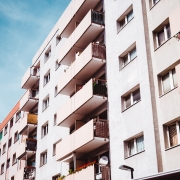Tobacco Prevention 2.0: Integrating Equity into Smoke-Free Multi-Unit Housing
Protecting the health and safety of everyone requires a new approach to policy
When it comes to housing vulnerable populations, tobacco prevention is essential. Tens of millions of Americans live in multi-unit housing (apartment buildings, condominiums, and other tightly-clustered living arrangements). A significant percentage of this housing is subsidized by the government.
Smoke-free building policies, which cover roughly one-third of multi-unit housing residences in the U.S., are intended to protect tenants from exposure to secondhand smoke, which can travel through open windows and under doors, seep in between shared walls, and blow through shared ventilation systems. Owners and managers of smoke-free housing also benefit from reduced fire risk and legal liability safeguards, lower maintenance costs, and maintenance of property value.
Research shows there is no level of safe exposure to secondhand smoke. In adults, health impacts range from mild nasal irritation to more severe health risks to the coronary, pulmonary, and reproductive systems.
In children, secondhand smoke can cause middle ear disease, compromise respiratory function, and even result in sudden infant death syndrome (SIDS). Secondhand smoke is also responsible for triggering asthma. About 1 in 20 children suffer from asthma, and of those, about 1 in 6 are treated at emergency departments or hospitalized, resulting in high medical bills, missed school (and work) days, and decreased quality of life.
The lack of policy around secondhand smoke is particularly harmful to children, people with lower income, people with less education, residents of rental and multi-unit housing, people who live with someone who smokes inside the home, and people in traditionally “blue collar” occupations. The Black population, in particular, is exposed to more secondhand smoke than other racial and ethnic groups. According to the Centers for Disease Control and Prevention:
As of June 2021, of the ten U.S. states with the highest proportion of Black residents, only three of those states have comprehensive smoke-free laws that prohibit smoking in all workplaces and public places. Of the seven states that do not have comprehensive laws, two also prevent local communities from adopting comprehensive smoke-free laws.
Smoke-free multi-unit housing policies have therefore been well-intentioned efforts to protect tenants from unwanted tobacco smoke. They have also, however, forced building managers to grapple with serious issues of equity: While it is not fair or right to expose tenants to someone else’s tobacco smoke, it is also ethically unsound to evict smokers with no other housing options available, particularly considering the U.S.’s current housing crisis.
Demand for housing that is in short supply for both homeowners and renters is sharply driving up the cost of homeownership and rent. The consequences are dire: billions of dollars in lost earnings, increased debt, overcrowded homeless shelters, more people living in their car or on the streets, and physical and emotional distress. It is neither a prudent public health nor ethical policy to force people out of their homes.
These dynamics have recently inspired a new take on smoke-free building policies. Cities in California, for example, have created equity-forward solutions that are less punitive toward the tenant while holding the HOA and/or landlord accountable for enforcing the policy before more extreme measures like tenant fines and eviction are implemented.
Berkeley’s Municipal Code 12.70 is one such example. Importantly, Berkeley’s policy is specifically framed to protect smokers, and eviction is not the preferred form of regulation and enforcement. Tenants who smoke are provided with adequate notice, education, access to comprehensive cessation resources, and reasonable accommodations.
Community groups advocating for smoke-free MUH policies, too, are adopting an equity-forward approach, ensuring affected tenants, and even smokers themselves, are involved in the process by sharing lived experiences, advising on policy details, and meeting with elected officials.
Solutions like the Smoke-Free Multi-Unit Housing Initiative are vital to preserving the health and well-being of tenants, property managers/owners, and community members without contributing to the housing insecurity crisis. The project advocates for eliminating extreme remedial measures such as massive fines or eviction in favor of a graduated, multi-step process that doesn’t shame or further threaten the health and well-being of smokers while also protecting non-smokers.
The tension between the needs and wants of smokers and non-smokers has plagued housing units for decades, and there are no easy solutions. These new, equity-forward approaches recognize the complexity of the problem and attempt to do a better job ensuring everybody – smokers and non-smokers alike – can live in housing that is healthy and safe.

